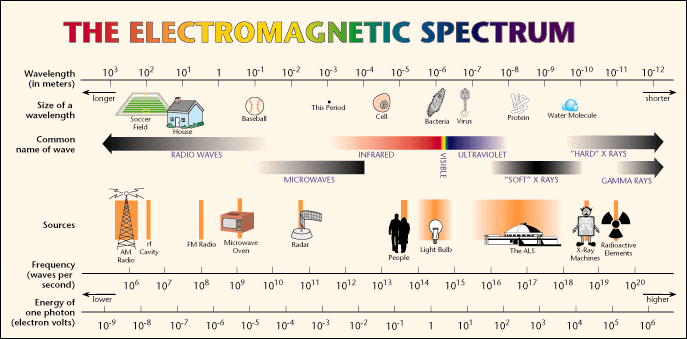

Radio waves are used to transmit radio and television signals. Radio waves have wavelengths that range from less than a centimeter to tens or even hundreds of meters. FM radio waves are shorter than AM radio waves. For example, an FM radio station at 100 on the radio dial (100 megahertz) would have a wavelength of about three meters. An AM station at 750 on the dial (750 kilohertz) uses a wavelength of about 400 meters. Radio waves can also be used to create images. Radio waves with wavelengths of a few centimeters can be transmitted from a satellite or airplane antenna. The reflected waves can be used to form an image of the ground in complete darkness or through clouds. Radio waves have the lowest frequency and longest wavelength. Their natural energy level is also the lowest in the electromagnetic spectrum. Man-made radio waves usually have a much higher energy level than those that exist in nature.
Microwaves are commonly used in two applications, radar and microwave ovens. The energy of these waves as produced by the sun is very low, but depending on the application, the man-made wave forms can vaßry tremendously. In most radar applications, these waves are transmitted with a very small amplitude (low energy). These waves are emitted at a specific frequency, and by using doppler principles, we are able to measure quantities like velocity and distance. Microwave wavelengths range from approximately one millimeter (the thickness of a pencil lead) to thirty centimeters (about twelve inches). In a microwave oven, the radio waves generated are tuned to frequencies that can be absorbed by the food. Microwave ovens use these waves to increase the motion of water molecules in food. The dish holding the food doesn't absorb a significant amount of energy and stays much cooler. This process requires a great deal of energy, and requires a safe sealed container, because of this, these ovens have a mandatory safety door that disables the microwave generator when the door is open. Microwaves are emitted from the Earth, from objects such as cars and planes, and from the atmosphere. These microwaves can be detected to give information, such as the temperature of the object that emitted the microwaves.
Infrared waves are waves just below the frequency of visible red light. Infrared waves include thermal radiation. For example, burning charcoal may not give off light, but it does emit infrared radiation which is felt as heat. Infrared radiation can be measured using electronic detectors and has applications in medicine and in finding heat leaks from houses. Infrared images obtained by sensors in satellites and airplanes can yield important information on the health of crops and can help us see forest fires even when they are enveloped in an opaque curtain of smoke.
These are the electromagnetic waves that form the visible color spectrum. Their wavelenths are between 400 and 700 nanometers. They are the frequencies most commonly produced by the sun. As more and more of these visible frequencies combine together they approach white light.
These waves range from 10 to 400 nanometers in wavelength. The energy of these waves as produced by the sun is great enough to burn human skin. Most of these waves are filtered out by the ozone but extended or constant exposure can cause skin cancer and or cataracts. Ultraviolet rays are used by many observatories and also contribute to stimulating plant growth.
X-rays are high energy waves which have great penetrating power and are used extensively in medical applications and in inspecting welds. X-ray images of our Sun can yield important clues to solar flares and other changes on our Sun that can affect space weather. The wavelength range is from about 10 nanometers to about 10 picometers.
Gamma rays have wavelengths of less than about 10 picometers. They are more penetrating than X-rays. Gamma rays are generated by radioactive atoms and in nuclear explosions, and are used in many medical applications. Images of our universe taken in gamma rays have yielded important information on the life and death of stars, and other violent processes in the universe.